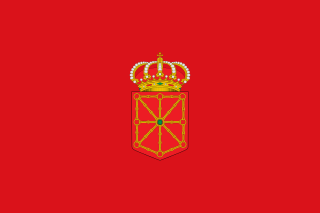
Navarre, officially the Chartered Community of Navarre, is a landlocked foral autonomous community and province in northern Spain, bordering the Basque Autonomous Community, La Rioja, and Aragon in Spain and Nouvelle-Aquitaine in France. The capital city is Pamplona. The present-day province makes up the majority of the territory of the medieval Kingdom of Navarre, a long-standing Pyrenean kingdom that occupied lands on both sides of the western Pyrenees, with its northernmost part, Lower Navarre, located in the southwest corner of France.

Pamplona, historically also known as Pampeluna in English, is the capital city of the Chartered Community of Navarre, in Spain.

The festival of San Fermín is a week-long, historically rooted celebration held annually in the city of Pamplona, Navarre, in northern Spain. The celebrations start at noon on July 6 and continue until midnight on July 14. A firework (Chupinazo) starts off the celebrations and the popular song Pobre de mí is sung at the end. The most famous event is the running of the bulls, which begins at 8 in the morning from July 7 to 14, but the festival involves many other traditional and folkloric events. It is known locally as Sanfermines and is held in honour of Saint Fermin, the co-patron of Navarre.

Lower Navarre is a traditional region of the present-day French département of Pyrénées-Atlantiques. It corresponds to the northernmost merindad of the Kingdom of Navarre during the Middle Ages. After the Spanish conquest of Iberian Navarre (1512–24), this merindad was restored to the rule of the native king, Henry II. Its capitals were Saint-Jean-Pied-de-Port and Saint-Palais. In the extreme north there was the little sovereign Principality of Bidache, with an area of 1,284 km2 (496 sq mi) and a decreasing population of 44,450, 25,356.

The Kingdom of Navarre, originally the Kingdom of Pamplona, was a Basque kingdom that occupied lands on both sides of the western Pyrenees, with its northernmost areas originally reaching the Atlantic Ocean, between present-day Spain and France.

Fuero, Fur, Foro or Foru is a Spanish legal term and concept. The word comes from Latin forum, an open space used as a market, tribunal and meeting place. The same Latin root is the origin of the French terms for and foire, and the Portuguese terms foro and foral; all of these words have related, but somewhat different meanings.

Francis Phoebus was King of Navarre (1479–1483), Viscount of Bearn, and Count of Foix (1472). He was the son of Gaston, Prince of Viana, and grandson of Queen Eleanor, whom he succeeded. She recommended him to ally with France.
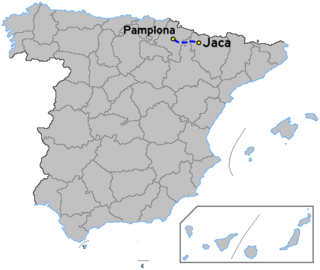
The Spanish Autovía A-21 is a highway between Jaca, in Aragon, and Iruña/Pamplona, in Navarre which is partially open and partially under construction.

Transporte Urbano Comarcal is a regional public transportation system operating in the city of Iruña/Pamplona.

Club Deportivo Iruña is a Spanish football team based in Pamplona, in the autonomous community of Navarre. Founded in 1939, it plays in Primera Autonómica de Navarra, holding home matches at Estadio Paternain, with a capacity of 3,000 seats. The club is named after the Basque language name of Pamplona.

Miren Uxue Barkos Berruezo, simply known as Uxue Barkos, is a Spanish journalist and politician who served as the President of Navarre from 2015 to 2019. She previously represented the Basque coalition Geroa Bai, and before that, Nafarroa Bai, in the Spanish Congress of Deputies.
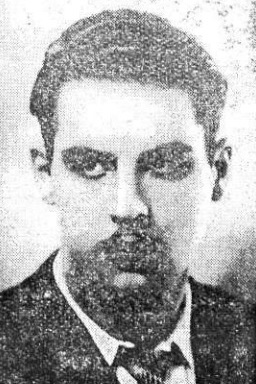
Jaime del Burgo Torres was a Spanish official, writer and a Carlist activist. He is noted mostly as a historian; his works focus on Navarre and the Carlist wars. As a public servant he is known as longtime head of Navarrese library network, regional Ministry of Information delegate and a governmental and self-governmental tourist official. As a Carlist he is acknowledged as moving spirit behind the Navarrese Requeté in the 1930s and as representative of the Carloctavista faction during early Francoism. He also wrote novels, poems and dramas.

Carlism was the dominant political movement in elections in Navarre during the period between the Third Carlist War and the Primo de Rivera dictatorship. The movement, defeated in 1876, during the Restauración period recalibrated its focus from military action to political means and media campaigns. Accommodating themselves to political framework of the Alfonsine monarchy, party leaders considered elections, and especially elections to Cortes Generales, primary vehicle of political mobilization. Navarre turned out to be the Carlist electoral stronghold; it elected 35% of all Carlist deputies voted into the parliament during almost 50 years of the monarchical liberal democracy. Though the phenomenon remained marginal from the national Spanish perspective, political prowess of Carlism in the province was key to sustain its potential until the movement regained momentum during the Second Spanish Republic.

Ignacio Baleztena Ascárate (1887–1972) was a Spanish folk customs expert, a Carlist politician and soldier.
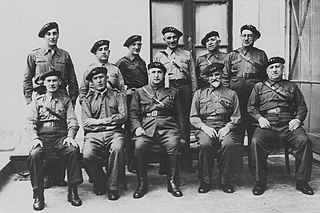
Joaquín Baleztena Ascárate was a Spanish Carlist politician. During three consecutive terms between 1919–1923 he served as a Traditionalist member of the Cortes. In two separate strings of 1931–1942 and 1951–1957 he headed the regional party organization in Navarre; he remained one of key nationwide Carlist politicians from the late 1910s till the early 1970s. In 1937–1939 he was a member of the Falange Española Tradicionalista y de las JONS executive, Consejo Nacional.

Amaiur-Maya is a village in the municipality of Baztan in the autonomous region of Navarre in Spain. It is situated in the Pyrenees mountain range close to the border with France.
The Gamazada is the popular reaction in Navarre in 1893 and 1894 to when the Spanish finance minister of the Liberal Party under Prime Minister Sagasta, Germán Gamazo, tried to suppress the fueros that had been established in the Compromise Act of 1841. It caused a huge uproar among the people and institutions of Navarre, with demonstrations and petitions.

Víctor Eusa Razquin (1894–1990) was a Spanish architect, active almost exclusively in Navarre; he left his personal mark on Pamplona, which hosts numerous prestigious and monumental buildings he designed. Eusa is best known for his version of art déco style, though he went also through eclectic, regionalist, rationalist, expressionist and neo-classical periods, with occasional references to historicism, beaux arts, neo-mudejár or Dutch neo-plasticism styles. His best known works are the San Miguel seminary and the Piarist college, both in Pamplona. In the mid-1930s he was engaged in politics and held a seat in the Carlist wartime executive in Navarre.
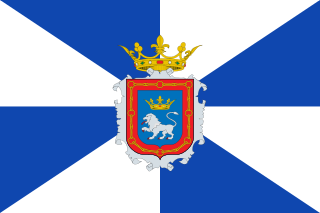
The History of Pamplona as a city goes back to the 1st millennium B.C. when a settlement of Vascones named Iruña existed. However, the traces of human occupation of the area date back 75,000 years. In the Roman era, the Vascones settlement was converted into a Roman city by General Pompey, who began by setting up a military camp there in 74 B.C. which he named Pompelo.


















